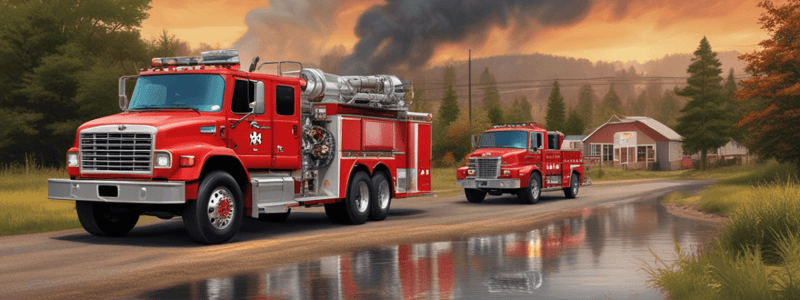Podcast
Questions and Answers
Which of the following is NOT a valid water supply strategy for a fire in a non-hydrant area according to the document?
Which of the following is NOT a valid water supply strategy for a fire in a non-hydrant area according to the document?
- Establishing a water shuttle operation to the closest fire hydrant.
- Utilizing the initial tank water supply of the first arriving apparatus.
- Using a porta-tank carried on the first arriving tender and drafting from it.
- Drafting water from a nearby lake or pond. (correct)
If additional water is needed during a fire in a non-hydrant area, how can the Incident Commander obtain it?
If additional water is needed during a fire in a non-hydrant area, how can the Incident Commander obtain it?
- By deploying the fire department's reserve water supply.
- By calling additional tenders using MABAS Box 5. (correct)
- By directing the first arriving tender to refill from the closest fire hydrant.
- By ordering the attack engine to draft water from a nearby source.
What is the primary factor that should be considered when deciding on water supply tactics in a non-hydrant area?
What is the primary factor that should be considered when deciding on water supply tactics in a non-hydrant area?
- The distance to the nearest fire hydrant.
- The GPM flow requirements and duration of the fire. (correct)
- The type of building involved in the fire.
- The number of responding fire apparatus.
According to the document, how often is the SOG on Rural Water Supply Operations re-evaluated?
According to the document, how often is the SOG on Rural Water Supply Operations re-evaluated?
What does the term 'MABAS Box 5' refer to in the document?
What does the term 'MABAS Box 5' refer to in the document?
What is the primary objective when deploying water supply strategies in a non-hydrant area?
What is the primary objective when deploying water supply strategies in a non-hydrant area?
According to the document, what is the role of the Incident Commander in managing water supply during a fire in a non-hydrant area?
According to the document, what is the role of the Incident Commander in managing water supply during a fire in a non-hydrant area?
Which of these statements accurately reflects the document's approach to water supply in non-hydrant areas?
Which of these statements accurately reflects the document's approach to water supply in non-hydrant areas?
Study Notes
Rural Water Supply Operations
- Purpose: To utilize water supply tactics in non-hydrant areas during fire suppression operations.
Initial Water Supply
- Initial tank water supply of the first arriving apparatus is to be utilized.
- Flows must be judiciously evaluated to maintain effectiveness and duration of required flows.
Additional Water Supply Strategies
- If additional water is needed, the Incident Commander may use one or more of the following strategies:
- Utilize a porta-tank carried on the first arriving tender and begin a drafting operation.
- Position the tender in close proximity to the attack engine and feed it using its initial water supply.
- Refill the tender by:
- Establishing a water shuttle operation to the closest fire hydrant using additional apparatus.
- Calling additional tenders using MABAS Box 5.
Studying That Suits You
Use AI to generate personalized quizzes and flashcards to suit your learning preferences.
Related Documents
Description
Test your knowledge of rural water supply operations with this quiz based on the Hoffman Estates Fire Department's Standard Operating Guidelines. NIMS compliant.




